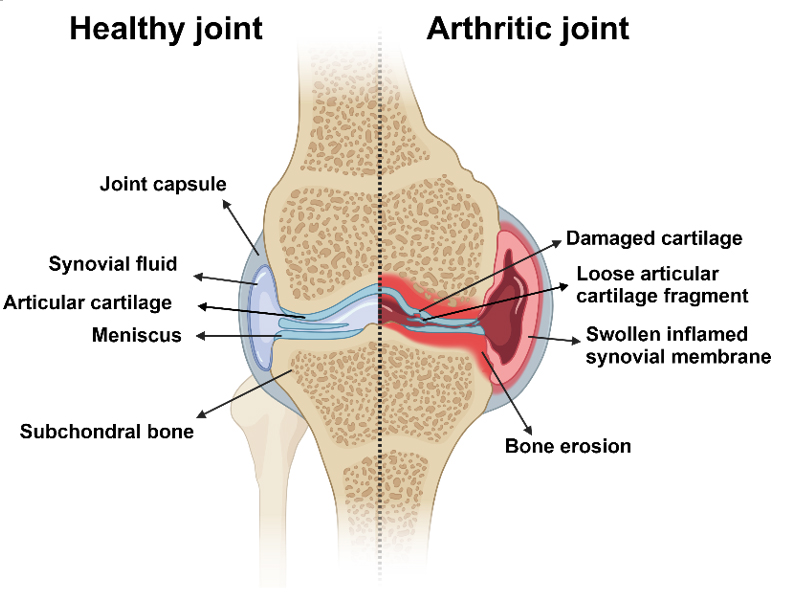Joint health is essential for your horse’s comfort and mobility as they work and age. Over time, multiple factors can contribute to joint damage and discomfort, including athletic trauma, repetitive wear, aging, inactivity, injuries that compromise joint stability, and developmental defects. One major cause of this discomfort is increased friction within the joint, which occurs when the natural joint fluid loses its ability to lubricate properly.

Synovial joints are the most common type of joint in a horse’s body. They have a special lining called synovium that produces synovial fluid, also known as joint fluid. This fluid is crucial for maintaining cartilage health, by delivering nutrients and removing waste, as cartilage lacks a direct blood supply. It also lubricates the cartilage, allowing joints to move smoothly with less friction. In a healthy joint, this fluid has a consistency similar to egg whites. However, when inflammation occurs, the joint fluid becomes thinner and more water-like, leading to increased friction and cartilage damage.
Joint damage can start in different ways. Sometimes cartilage is the first to be affected, triggering inflammation as the body responds to the buildup of waste products and debris inside the joint. In other cases, inflammation begins in the synovium and then damages the cartilage, setting off a cycle of deterioration. As this process continues, cartilage breaks down faster than it can heal. When too much cartilage is lost, the underlying bone is exposed to excessive pressure, leading to new bone growth. Even if the initial injury was purely mechanical (i.e., the cartilage was damaged first), ongoing inflammation can continue to drive joint deterioration.
Osteoarthritis (OA) is a common problem in horses characterized by a loss of cartilage in the joint. It is estimated that 60% of lameness is due to OA, and 50% of horses will develop OA by the time they reach 15 years old. One of the key contributors to this process is the loss of effective joint lubrication. Without sufficient lubrication, cartilage damage accelerates, leading to advanced tissue damage and discomfort.
Hyaluronic acid (HA) injections are often used to restore joint lubrication since this function is so important for healthy joints. As there are many different variations in HA products including viscosity, molecular weight, presence of cross-linking, concentration of HA, and the source that it is created from, there can be variability in how well each product performs. As a natural product, HA is also subject to the same breakdown that causes thin joint fluid; therefore, its time in the joint is typically brief. It has also been shown that damage to the cartilage surface limits HA’s ability to decrease friction in affected joints.
Due to the limitations of joint fluid and injected HA to provide quality lubrication for longer periods of time in diseased joints, a growing interest was placed on the development of synthetic lubricants. Noltrex®Vet is a synthetic lubricant, consisting of a polyacrylamide hydrogel, that has the ability to greatly decrease friction. Unlike traditional HA injections, a portion of the Noltrex®Vet gel remains localized on the cartilage surface, forming a layer that protects the cartilage from excessive friction.
Another key advantage of Noltrex®Vet is its durability. As it is synthetic, it does not break down as quickly as natural joint fluid or HA injections. Instead, it provides long-lasting lubrication before gradually being eliminated from the joint over time. This removal process makes Noltrex®Vet suitable to be used throughout a horse’s lifetime without accumulating or causing unwanted side effects from a prolonged presence after the product has been worn down due to mechanical friction several weeks following injection.
Joint injections tend to have a prolonged therapeutic effect, where horses demonstrate comfort for periods that extend significantly beyond the lifespan of the product injected. When a product is injected into the joint, it can shift the joint away from a destructive cycle towards one of repair. The shift towards these repair mechanisms allows the joint to care for itself again. Eventually, the inflammatory cycle is likely to return, but this time period is different for every horse depending on the degree and type of tissue damage, how hard they work, aging, and other factors. Veterinarians generally report a 2-4 times longer clinical effect when they utilize Noltrex®Vet compared to treatments without.
Maintaining joint health often requires a multi-modal approach. Noltrex®Vet offers effective lubrication to reduce friction, and can be included with other treatments that directly manage inflammation, pain, and tissue healing. In cases where inflammation is controlled, it may also be suitable to use Noltrex®Vet as a monotherapy. Your veterinarian will determine the best combination of therapies for your horse’s specific needs, and when each product should be used.
References:
Bullogh, P. (2010). The Dysfunctional Joint. In Orthopaedic Pathology (pp. 231–252). Elsevier.
Bonnevie, E. D., Galesso, D., Secchieri, C., & Bonassar, L. J. (2018). Degradation alters the lubrication of articular cartilage by high viscosity, hyaluronic acid-based lubricants. Journal of Orthopaedic Research, 36(5), 1456–1464.
McIlwraith, C. W., Frisbie, D. D., & Kawcak, C. E. (2012). The horse as a model of naturally occurring osteoarthritis. Bone & Joint Research, 1(11), 297–309.
Vishwanath, K., McClure, S. R., & Bonassar, L. J. (2023). Polyacrylamide hydrogel lubricates cartilage after biochemical degradation and mechanical injury. Journal of Orthopedic Research, 41(1), 63-71.
Vishwanath, K., Secor, E. J., Watkins, A., Reesink, H. L., & Bonassar, L. J. (2024). Loss of effective lubricating viscosity is the primary mechanical marker of joint inflammation in equine synovitis. Journal of Orthopaedic Research, 42(7), 1438–1447.
Understand how early osteoarthritis intervention is vital to your horse’s wellbeing.
We will send information about Noltrex®Vet directly to your veterinarian.